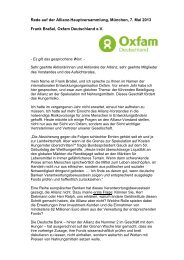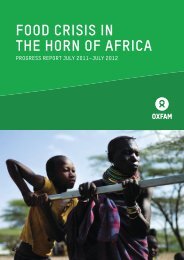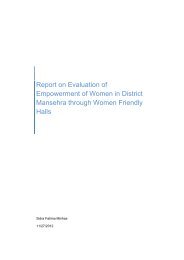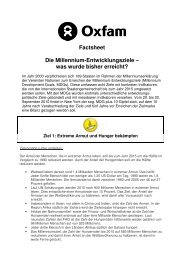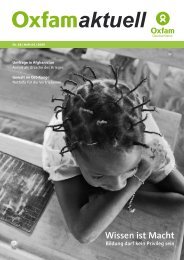shape - Oxfam
shape - Oxfam
shape - Oxfam
Create successful ePaper yourself
Turn your PDF publications into a flip-book with our unique Google optimized e-Paper software.
IN PROFILE<br />
The bridge of hope:<br />
The purpose of this activity<br />
is to educate students<br />
about different ways to<br />
protect themselves from<br />
HIV and other sexually<br />
transmitted infections.<br />
4. Addressing HIV and AIDS<br />
from a gender perspective.<br />
Transforming inequitable gender<br />
relations and promoting gender<br />
justice is at the heart of SHAPE’s<br />
work and is what sets it apart from<br />
many other HIV interventions. From<br />
the outset, SHAPE acknowledged<br />
the different impacts HIV and AIDS<br />
were having on men and women<br />
and therefore designed its<br />
intervention to bring about<br />
behaviour change in gender<br />
specific ways. The project’s main<br />
objective is to understand the<br />
different contexts in which risky<br />
behaviour takes place for male and<br />
female students and to address<br />
these specific female and male<br />
concerns. By doing this SHAPE<br />
has made gender issues<br />
prominent on the HIV prevention<br />
agenda in universities and the<br />
wider community.<br />
IT’S AMAZING HOW WE (MEN) THOUGHT<br />
THAT GENDER WAS ABOUT WOMEN BUT NOW<br />
WE CAN ACTUALLY DESCRIBE HOW GENDER<br />
DEFINITIONS CHANGE OVER TIME AND FROM<br />
PLACE TO PLACE. FIRST-YEAR MALE STUDENT.<br />
5. Using behaviour change<br />
theories to inform the program.<br />
SHAPE has successfully grown<br />
its intervention to a point where<br />
it now offers ongoing, year-long<br />
activities rather than once-off<br />
events. Through its post-training<br />
activities, it is able to walk<br />
students through a behaviour<br />
change process and provide<br />
continuous support aimed at<br />
sustaining long-term behaviour<br />
change. The SHAPE project is<br />
also designed to respond to<br />
three key factors, as outlined<br />
in the PRECEDE Health Model<br />
(Predisposing, Reinforcing and<br />
Enabling Constructs in Ecosystem<br />
Diagnosis and Evaluation):<br />
a) pre-disposing factors<br />
such as particular attitudes<br />
and beliefs that facilitate<br />
risk-taking behaviour;<br />
b) reinforcing factors such<br />
as peer pressure or religion,<br />
which make an individual<br />
willing or unwilling to<br />
change; and<br />
c) enabling factors within<br />
universities, such as<br />
the lack of recreational<br />
activities, which provide<br />
a conducive environment<br />
for risk-taking behaviour.<br />
The SHAPE intervention is<br />
therefore designed to influence<br />
both individuals and these<br />
social factors.<br />
TOP LEFT: SHAPE’s masculinities workshops<br />
aim to improve male students’ attitudes towards<br />
gender quality. OPPOSITE: Students take part<br />
in “The bridge of hope” activity, designed to<br />
educate students about HIV and AIDS. Photos:<br />
William Nyamuchengwa/<strong>Oxfam</strong>AUS.<br />
Participants try to cross a narrow<br />
bridge, over a river infested with<br />
crocodiles, hippopotamuses and<br />
other dangers, to the future which<br />
awaits them on the other side.<br />
For those who fall off, a second<br />
bridge is later added, enabling<br />
them to cross safely.<br />
The bridges are represented<br />
by two sticks, each about two<br />
metres long and 2–3cm wide;<br />
one is painted yellow and the<br />
other painted half blue and half<br />
white. The bridges represent the<br />
ways to avoid HIV and AIDS in<br />
order to go through life safely.<br />
White stands for abstinence –<br />
no sex or delaying sex –<br />
blue represents faithfulness<br />
or monogamy and yellow<br />
represents using a condom or<br />
receiving support from peers,<br />
parents and others.<br />
First the blue and white stick is<br />
laid down on the ground and<br />
various “dangers” are placed<br />
on both sides of the stick.<br />
These “dangers” are pieces<br />
of paper with pictures of<br />
crocodiles, hippopotamuses<br />
and other dangerous animals<br />
on them and represent the<br />
dangers that people can see.<br />
Participants are then invited<br />
to try and cross the bridge,<br />
heel to toe, all the way from<br />
the white end to the blue end.<br />
When someone succeeds,<br />
everyone claps and cheers<br />
and is congratulated. The peer<br />
educators then reassure those<br />
who fell off the bridge that<br />
another bridge will be added<br />
to help them get across safely.<br />
The yellow stick is then laid<br />
on the ground, about 30cm<br />
parallel to the other stick.<br />
This time “hidden” dangers are<br />
added to the river – things<br />
such as HIV. Photos of ordinary<br />
men and women are used to<br />
represent these hidden dangers.<br />
Now, with the yellow stick in<br />
place, participants are invited to<br />
try and cross the white and blue<br />
bridge again, using the yellow<br />
bridge as support to get<br />
across safely if needed.<br />
When each person gets<br />
across everyone celebrates.<br />
After the exercise, peer<br />
educators and participants<br />
come together to discuss their<br />
experiences and what helped<br />
them to cross the bridge safely –<br />
receiving encouragement and<br />
support from others, focusing<br />
on what they were doing and<br />
where they wanted to end up,<br />
and making use of the different<br />
choices available. They then link<br />
this back to HIV and AIDS and<br />
real life.<br />
Peer educators also<br />
use the photos of men and<br />
women to initiate discussions<br />
about stigma and discrimination<br />
around HIV and AIDS. They<br />
ask participants to look at the<br />
photos and try and identify which<br />
people are living with HIV; this<br />
helps them realise that people<br />
living with HIV look no different<br />
than those who don’t have<br />
the virus.<br />
This simple exercise creates a<br />
real, physical experience of life<br />
and how to protect oneself from<br />
HIV and AIDS. The journey from<br />
white to blue and then yellow<br />
represents the path of a<br />
relationship – starting out with<br />
abstinence, and then moving<br />
onto faithfulness in a long-term,<br />
committed relationship. Yet, not<br />
everyone can abstain or be<br />
faithful all the time and so must<br />
use condoms or turn to the<br />
support of friends and family<br />
to go through life safely and<br />
avoid the dangers, both visible<br />
and hidden, which are always<br />
close-by.<br />
24 25


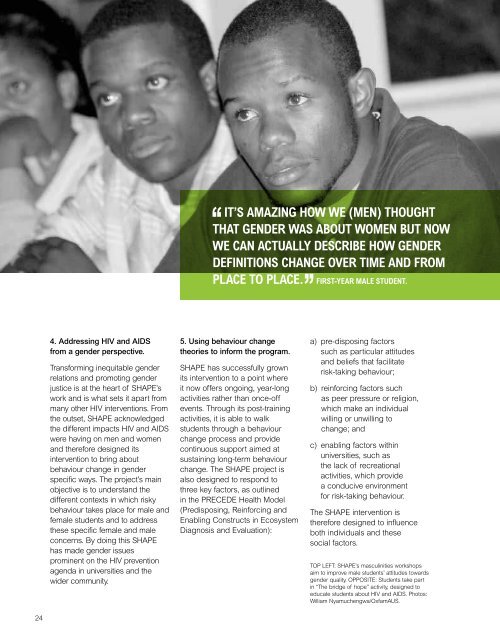
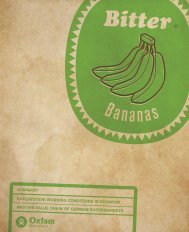
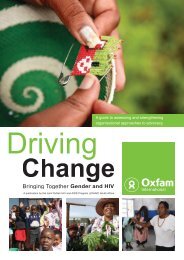
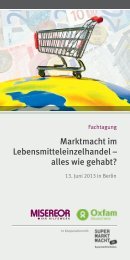
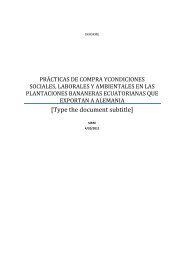

![Download: Faltposter EU-Handelspolitik [PDF 2,17MB] - Germanwatch](https://img.yumpu.com/25095854/1/190x161/download-faltposter-eu-handelspolitik-pdf-217mb-germanwatch.jpg?quality=85)
